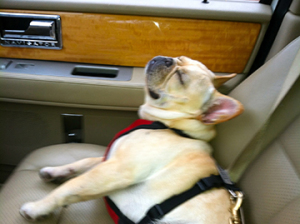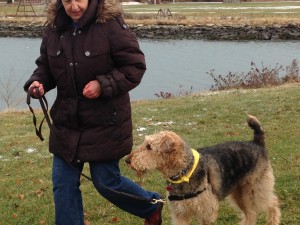This is the first of a five part segment, to help dog owners with dogs that act aggressively to strangers. A practical guide to helping owners with dogs who rush and bark at people through windows, fences, at the front door and on leash. If your dog displays these behaviors, at guests when they enter, your dog may be shy or fearful of strangers. Reducing his fear is essential to changing his behavior. Keep in mind this behavior can simply be frustration as well, determining the difference is another topic!
Now, Steps in helping the dog who is barking and lunging at people.
Step 1. Management; prevent him from practicing the unwanted behavior.
Step 2. Desensitization and counter condition; change how your dog feels.
Step 3. Understanding your dogs Distance Cues.
Step 4. Emotional Control Exercises; help your dog have better impulse control.
Step 5. Adding Criteria and Generalization
Let’s start by understanding how to effectively manage the adolescent dog so he is not becoming worse during your training. The key is to prevent your dog from practicing this barking behavior when in the home, car, yard, or anywhere.
Management: means changing the environment so your dog is not being put in a situation that triggers his fear or pushes him over threshold to this barking behavior. These negative experiences will slow your training process and are often practiced as they are rewarding to your dog. Behaviors that are practiced will not fade or change, so management is essential during your training.

For example, if your dog barks at people when in the car, you can put your dog in a comfortable crate with chew toys and a light sheet over it so your dog cannot see people. Before putting your dog in any crate, you want to condition this crate as a safe and comfortable place to be. Feeding your dog in the crate for several days can help your dog feel safe in this crate. Another option is to tape some wax paper up to the inside of the car windows, while not a fashion statement, it can be effective.
For the dog that runs the fence line barking daily, this behavior should not be allowed to occur. Fences can often cause frustration, so spending time with you dog outside is essential to prevent unwanted chasing and barking. You might consider moving the fence to the back yard only so your dog can not see people passing.
Windows in the home can easily be covered with wax paper to block the view as this can be a trigger for barking. Moving the furniture so your dog cannot sit high enough to see out, or using baby gates to block access to these environments is also recommended as effective management.
 While out for a walk on a leash, I suggest you have a plan to avoid people within the distance that makes your dog become aroused or stressed until you have a chance to desensitize and counter condition this behavior. If your dog can pass a person 40 feet away without showing signs of stress or arousal, then this is where you should keep your dog so he is having a successful walk with little stress.
While out for a walk on a leash, I suggest you have a plan to avoid people within the distance that makes your dog become aroused or stressed until you have a chance to desensitize and counter condition this behavior. If your dog can pass a person 40 feet away without showing signs of stress or arousal, then this is where you should keep your dog so he is having a successful walk with little stress.
My next blog in this series will complement the management techniques discussed here. It will detail exactly how to change this type of behavior using the scientific approach  of desensitization and counter conditioning. This is how I helped many clients dogs and changed my Scotty’s behavior after adopting her at 5 years of age. The complete timeframe for this process can be from 6-months to 2-years, depending on the dog. For my Scotty this process took 18 months, and it was well worth the effort as she is now living a much calmer and happier life! See you soon for more practical training for dogs who bark at humans.
of desensitization and counter conditioning. This is how I helped many clients dogs and changed my Scotty’s behavior after adopting her at 5 years of age. The complete timeframe for this process can be from 6-months to 2-years, depending on the dog. For my Scotty this process took 18 months, and it was well worth the effort as she is now living a much calmer and happier life! See you soon for more practical training for dogs who bark at humans.


